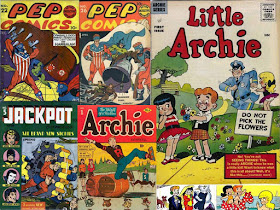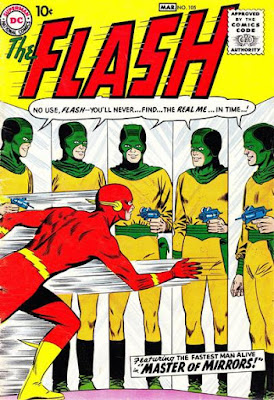Steve Rogers was the first Captain America, but he wasn't the only one. Another man to be Cap was Jeff Mace.
Reporter. Hero.
American. Patriot.
Here's a little of the history of the man who was the Patriot, and gave up that identity to become Captain America!
Golden Age
Jeff Mace began life as the Patriot in
Human Torch #4 (Spring, 1941 by
Ray Gill and
George Mandel, though the issue was
#3 on the cover), appearing in the next issue (
Human Torch #4/5), then moving over to
Marvel Mystery Comics starting with
#21 (July, 1941), where he was a regular feature until
Marvel Mystery Comics #74 (July, 1946), using his athletic ability and reporter's skills to fight menaces.
Along the way, he even gained a partner, Miss Patriot (Jeff's friend, Mary Morgan), who gained powers of above normal hearing and super-vision in
Marvel Mystery Comics #50 (December, 1943), getting him a little extra help on his cases.
All these appearances, and the Patriot never made a cover in the Golden Age, so settle for a few of his splash pages to show his original costume!
This was also the costume Rick Jones manifested him during
the Kree-Skrull War (but that wasn't really Jeff Mace....).
1970s Revival
With the success of the Invaders in the 1970s (a team composed of the
original Captain America, the original Human Torch and Sub-Mariner formed in an issue of the
Avengers during a time travel adventure), more classic Timely characters were given new life, detailing their adventures during World War II, this time as the homefront heroes, the Liberty Legion, including the Whizzer, Miss America, the Thin Man, Jack Frost, Blue Diamond, Red Raven and the Patriot...
...starting in
Invaders #5 (March, 1976 by
Roy Thomas,
Rich Buckler,
Dick Ayers and
Jim Mooney), continuing into
Marvel Premiere #29 (April, 1976 by
Roy Thomas,
Don Heck and
Vince Colletta),
Invaders #6 (May, 1976 by
Roy Thomas,
Frank Robbins and
Vince Colletta) and
Marvel Premiere #30 (June, 1976 by
Thomas,
Heck and
Colletta), with all the heroes gathering to battle the Red Skull (under
Jack Kirby covers, no less!). The Liberty Legion returned in
Invaders #35 to
#38 (December, 1978 to March, 1979), as well as alternate Earth versions of the team meeting the Thing in
Marvel Two-In-One Annual #1 (1976) and
Marvel Two-In-One #20 (October, 1976).
The big change for the Patriot happened in
What If? #4 (August, 1977 by
Roy Thomas and
Frank Robbins), where he helped the former Invaders and
their new Captain America and Bucky against the android, Adam II, who killed the second Captain America....resulting in Jeff Mace making the decision to take up the spirit of liberty, and become the newest Captain America, where he remained until he couldn't any more (with this history recognized in
Captain America #215 in November, 1977), retiring to go back to reporting, and another man was assigned by the government to become
the fourth Captain America.
End Of The Line
Jeff Mace got a little help from the Contemplator in
Captain America Annual #6 (1982 by
J. M. DeMatteis,
Ron Wilson and
Vince Colletta) to become Captain America once more, saving an alternate Earth from an alternate Adam II with help from Steve Rogers! This was important to Jeff Mace, who needed a good last shot at being a hero, as he was dying of cancer, eventually passing away in
Captain America #285 (September, 1983 by
J. M. DeMatteis,
Sal Buscema and
Kim DeMulder).
Life Of The Legend
Patriot got some of his history filled in with later looks back at Timely's Golden Age...
...with the longest look back coming in
Captain America: Patriot mini-series, with four issues from November 2010 to February, 2011, really getting into the mind of Jeffrey Mace and his added history!
Karl Kesel and
Mitch Breitweisser gave the Patriot a fuller origin, having reporter Jeffrey Solomon Mace be influenced by Captain America to become a hero, detailing how he took over as the third Captain America, working with the All-Winners Squad, FBI liaison Betsy Ross (who would become Golden Girl), Miss Patriot, the shooting of his Bucky, and how the FBI didn't want him as Captain America as the threat of Communism loomed over America, making Jeff lack trust in the USA, and retire from being Captain America.
Captain America History
Though the comics treated Captain America and Bucky as the originals, Jeff Mace and Fred Davis' versions of Captain America and Bucky had their Golden Age adventures, starting with
Captain America Comics #59 (November, 1946), continuing into
All-Winners Comics #21 (Winter, 1946-1947, facing Future Man and Madame Death with the All-Winners Squad), then from
Captain America Comics #60 (January, 1947) to
Captain America Comics #73 (July, 1949), and even titles like
Blonde Phantom #16 (Winter, 1947-1948),
Sub-Mariner #31 (April, 1949) and
Captain America's Weird Tales #74 (October, 1949), and even to his home,
Marvel Mystery Comics, for issues
#80 to
#84,
#86 to
#88, #91 and
#92 in the 1940s (but this time as Captain America).
Captain America faced many new foes at this time, like the Human Fly, the Black Baron, Mr. Polly, King Lear, the Acrobat, the Chief, and even Lavender....who shot Bucky and was the villain that Betsy Ross first faced, in her new super-hero identity as the Golden Girl (in
Captain America Comics #66 in April, 1948 by
Bill Woolfolk and
Syd Shores).
Bucky (Fred Davis) stayed on the sidelines from this point onward (returning briefly to face the Trickster in
Captain America Comics #71 of March, 1949), and Golden Girl gave up her costumed identity after
Captain America Comics #73 (July, 1949).
Jeff Mace's Captain America even faced his own Red Skull....
...facing off against the dead villain in the odd
Captain America's Weird Tales #74 (October, 1949), as the Red Skull got the lord of the underworld to bring Cap to hell for one last battle....(and the rest of the tales of this and the next issue were supernatural ones, not relating to Captain America). Through all this, Captain America triumphed....a Patriot (this time, represented by Jeff Mace).






















































